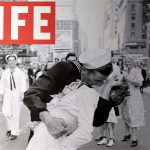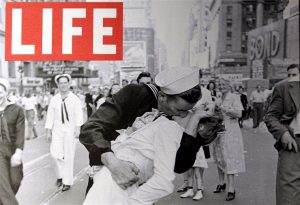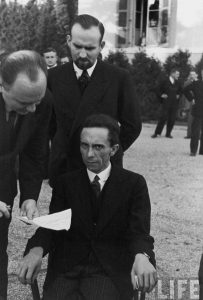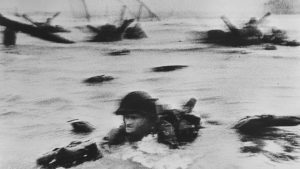Shot by a Jew
By Robert Liebman
 A gaggle of American GI’s (Government Issue = soldier) raise the Stars and Stripes on a bomb-damaged hilltop.
A gaggle of American GI’s (Government Issue = soldier) raise the Stars and Stripes on a bomb-damaged hilltop.
A sailor and a nurse enjoy a passionate kiss in Times Square.
General Douglas MacArthur returns, knee-deep, to the Philippines.
The truly iconic photographs from the Second World War are instantly familiar. We can picture them from a brief description alone; we do not actually need to see them.
Several other widely reproduced WW2 photographs might also ring a few memory bells:
A soldier raises the Soviet Hammer and Sickle over the Reichstag in Berlin.
A young woman in a bathtub casually scrubs her shoulder alongside a framed photo of Adolf Hitler.
German Field Marshal Friedrich Paulus surrenders in Stalingrad.

Many famous Second World War pictures were taken by Jewish photographers.
Joe Rosenthal, the Associated Press photographer at the flag-raising at Iwo Jima, was of Russian Jewish descent. After the American army rejected him because of his poor eyesight, AP signed him on.
 The sailor and the nurse were immortalised by Alfred Eisenstaedt, a German Jew who fled Nazism in 1935. Based in New York, “Eisie” specialised in celebrity portraits and was dubbed the “Father of Photojournalism.” Before he fled the Nazis, Eisenstaedt produced a riveting 1933 portrait of a scowling Josef Goebbels.
The sailor and the nurse were immortalised by Alfred Eisenstaedt, a German Jew who fled Nazism in 1935. Based in New York, “Eisie” specialised in celebrity portraits and was dubbed the “Father of Photojournalism.” Before he fled the Nazis, Eisenstaedt produced a riveting 1933 portrait of a scowling Josef Goebbels.
The beauty in the bathtub is model-turned-photojournalist Lee Miller, photographed by her colleague (and lover), David Scherman, an American Jew and Life magazine lifer who became a major editor at the publication after the war.
When the German Sixth Army’s situation was so dire that even Hitler had to admit it, the Nazi leader promoted Friedrich Paulus to Field Marshal in the hope that Paulus would do what German field marshals traditionally did in those circumstances: commit suicide.
Paulus had another idea. He surrendered, thereby presenting Stalin with a stupendous photo opportunity. Taking no chances, the Soviet ruler sent his best photographer, Odessa-born Roman Karmen, real name Roman Lazarevich Kornman, to the vital city on the Volga.
A sixth eminent World War Two photographer, Robert Capa (1913-1954), deserves inclusion here, even if his best-known photo is from the Spanish Civil War.

Robert Capa at Omaha Beach
On D-Day (June 6, 1944), Capa waded ashore with American soldiers at Omaha Beach, taking photos with, unsurprisingly given the conditions, wobbly focus but enormous authenticity. Hungarian-born Capa’s legal name is Endre Ernő Friedmann. He is best known for his photo of a mortally wounded soldier just as he was shot on a hillside during the Spanish civil war.
Capa was the guiding force behind the creation of the famous photographers’ collective Magnum two years after the end of the war. Magnum photographers owned the copyright to their pictures, giving them additional income with each future sale.
David Seymour, a Magnum co-founder, was born in Warsaw to Regina and Benjamin Szymin,who published Hebrew and Yiddish books. His nickname, “Chim,” was the English pronunciation of his surname.
Another co-founder, George Rodger, covered the liberation of Bergen-Belsen and, although not Jewish, it altered his career. The Magnum website notes that “He would give up war photography forever after finding himself ‘getting the dead into nice photographic compositions’ upon entering the concentration camp.”
Different wars claimed the lives of the two Jewish Magnum founders. Capa stepped on a mine in Vietnam in 1954, and Seymour was killed during the 1956 Suez crisis.
Jewish war photographers in the Soviet Union were also numerous.
American academic David Shneer studied photos of Majdanek in the Soviet press and was surprised to discover that three of the four photographers were Jewish, “including the most famous photojournalist of that era, Evgenii Khaldei.” Shneer then found many more, including Arkady Shaykhet, Alexander Grinberg, Mark Markov-Grinberg, Max Alpert and Dmitri Baltermants. Shneer’s Through Soviet Jewish Eyes: Photography, War, and the Holocaust was published in 2011.
Baltermants’ Grief: Searching for the Loved Ones at Kerch, with its stark depiction of a distraught woman searching among frozen bodies, is well known in Russia and has been widely reproduced in English-language war books.
Before the war Lee Miller (the beauty in Hitler’s bathtub) had been involved personally and artistically with the artist Man Ray, a Dada and surrealist painter-photographer widely believed to be French. Actuellement, he was born Emmanuel Radnitzky in America.
The list of Jewish snappers also include Alfred Stieglitz, Diane Arbus, Annie Liebowitz, Weegee (Ascher Fellig) and the German-born Gerty Simon and Erwin Blumenfeld. ###
Copyright 2024 by Robert Liebman. All rights reserved.
